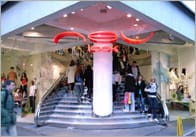What is Continuous Provision? A Guide to Play-Based Learning in EYFS & KS1

What is continuous provision?
Continuous provision is a method of early education that focuses on offering children a rich and varied learning environment where they can engage with different activities and materials at their own pace. This method encourages exploration and discovery, with teachers playing a crucial role in observing, modelling, and guiding learning through thoughtful interactions and providing carefully considered, challenging and open-ended resources. Underpinning this method is the belief that children learn most effectively through hands-on experiences and play.
Continuous provision goes beyond just providing materials—it should function as a child-led learning strategy. Carefully selected and strategically placed resources should enable independent learning, even when adults are not directly involved. The best learning environments allow children to direct their own exploration while being subtly supported by practitioners. As Anna Ephgrave (Early Years Consultant & Author of The Nursery Year in Action) notes:
“Children learn best when they are actively engaged, making choices, and following their own interests. Continuous provision should provide opportunities for deep, sustained learning through play.”
The benefits of child-led, open-ended play
Child-led learning through play offers so many benefits. Giving children the freedom to make their own choices and experiment within a structure tailored to their particular interests can boost confidence, independence and engagement. They are more likely to remain engaged, motivated, and excited about discovering new concepts. It can also help with perseverance and problem solving – as children navigate challenges within their play they naturally develop resilience, and the ability to think critically to overcome obstacles. Open-ended play can also encourage creative expression and stimulate inventive, imaginative thinking.
How to set up effective continuous provision
It’s important to critically assess your environment – what are the strengths and weaknesses? The learning environment should reflect what children already understand, the skills they’ve developed, and what they need to work on next. You need to adapt your provision according to what the children need support with to meet their developmental needs whilst also looking at their particular interests and current skill-set. Adaptability in continuous provision is crucial.
Continuous provision should appear playful and feel natural but to achieve this requires a lot of reflection and preparation. As Steve Jobs once said “It takes a lot of hard work to make something simple”.
Effective provision carefully considers the core skills children are developing within each area. Reflect on the purpose of each area, the learning it supports and whether children interact with it as you envisioned. The goal is to provide materials that spark curiosity, stretch thinking, and encourage children to apply existing knowledge in new ways.
You should modify your core continuous provision with optimisations based on children’s interests, current themes, or targeted skill development. These optimisations can be further augmented by complementary adult-led activities that build upon and deepen children’s independent exploration.
In summary, when reviewing your continuous provision consider these steps:
1) Assess your space – What works well? What needs improvement? Ensure the environment reflects children’s interests and developmental needs.
2) Adapt provision regularly – Modify activities to support emerging skills and individual learning goals.
3) Provide open-ended resources – Offer materials that challenge thinking and encourage creativity.
4) Ensure a balance of freedom & guidance – Create a space where children explore independently but with meaningful adult interaction.
5) Observe & refine – Monitor engagement levels and adjust areas based on children’s responses.
The role of adults in continuous provision
Whilst it’s really important not to make continuous provision overly adult-led, the role of the adult is crucial. Practitioners should strike a balance, offering subtle guidance while allowing children the freedom to explore, experiment, and discover for themselves.
In addition to the behind the scenes work required to set up the environment, and the work of observing, it’s important that practitioners are open to providing thoughtful, meaningful interactions with children during their self-directed play. As Professor Iram Siraj notes:
“Quality interactions between adults and children enhance continuous provision. Skilled practitioners scaffold learning in ways that extend children’s thinking, encouraging them to engage more deeply.”
Free continuous provision planning ideas
For practical inspiration, take a look at these free EYFS Outdoor Continuous Provision Ideas. This resource offers a wealth of suggestions to support the development of purposeful and engaging provision, particularly in outdoor settings. However, this resource should be seen as a useful guide that you can adapt and build upon rather than a detailed plan to implement out of the box. To facilitate meaningful learning opportunities your provision needs to be responsive and child-centred. You must avoid following a rigid scheme of work and instead listen to and reflect the natural curiosities that you see in your particular setting.
Final thoughts
Ultimately, continuous provision is not a fixed endpoint but an evolving process. By embedding child-led learning opportunities throughout the environment, we empower children to revisit, refine, and extend their skills in ways that are meaningful to them. With careful thought and skilled support it’s possible to create an environment that is reassuring, stimulating, challenging and which is in tune with children’s developmental needs.
It may seem a bit daunting but it’s important to remember that effective continuous provision can lead to higher levels of engagement, increased wellbeing, and improved learning outcomes. By fostering a dynamic, child-centered learning environment, continuous provision supports holistic development, helping children build essential skills in a way that feels natural, enjoyable, and meaningful.
Want more EYFS & KS1 teaching ideas? Subscribe for free resources and expert insights on play-based learning!
Popular Teaching Resources
Stay Up To Date
Sign up for our newsletter and we’ll let you know when we create new early years resources.





